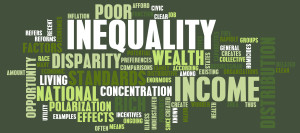3 Recent Reports on the Unsustainable Income / Wealth Chasms
There has been, and always will be, a wealth gap between the rich and the poor. It’s the degree of this disparity that is the issue. The current global wealth chasm has reached a dangerous threshold. So has the income chasm. Within the last month, 3 reports on the unsustainable income / wealth chasms were released by organizations that do excellent research on the issue. They confirm that the gulf between rich and poor is wide and growing wider. It is now obscene enough that it is deemed newsworthy by mainstream media.
CCPA: “Staying Power: CEO Pay in Canada”
This month, the Canadian Centre for Policy Alternatives (CCPA) released its annual report on CEO remuneration in Canada. Mainstream Canadian media such as the Toronto Star, the CBC, The Business News Network (BNN), and Maclean’s magazine covered it. On average, the top 100 CEO executives were paid $8.96 million in 2014. John Chen, CEO of BlackBerry, made $89.7 million in 2015. BlackBerry? $89.7 million!? Those who support outrageous CEO compensation on the grounds that CEOs are paid for performance may need to rethink their argument.
The ratio of CEO compensation to average worker compensation was 184:1 in Canada in 2014 — it was 373:1 in the United States. To add insult to injury, most of the remuneration was in the form of stock options that are only taxed at half the rate of base salary. The system is rigged so that the rich get richer. This level of excessive income disparity is not only socially unjust; it’s unjustifiable.
WEF: “Global Risks 2016”
Every year, just before it hosts the annual gathering of the rich and powerful in Davos, Switzerland, the World Economic Forum (WEF) releases its global risks report. Global risks are uncertain events or conditions that can cause significant negative impact for countries or corporations within the next 10 years. “Global Risks 2016” identifies 29 such risks. Three of them are: profound social instability, unemployment and underemployment, and large scale involuntary migration. The study identified the global trend that is driving all three risks: rising income and wealth disparity. As Thomas Piketty foreshadowed, soaring inequality contributes to economic instability. It jeopardizes world economies and corporations. For companies, it’s getting personal.
Oxfam: “An Economy for the 1%”
Oxfam released its annual report on wealth inequities to coincide with the same WEF Davos gathering. It found that the gap between the ultra-rich and the rest of the 99.99% of us is the widest ever. The richest 62 people in the world own the same as the bottom 50% of the world. That is, 62 billionaires own $1.76 trillion, which is the cumulative wealth of the bottom 3.5 billion people in the world. That injustice is unsustainable.
The Oxfam report warns that the wealth disparity is worsening. The wealth of the richest 62 people has risen by 44% since 2010, while the wealth of the poorest 3.5 billion fell 41%. Plus the global network of off-shore tax havens enables the super-rich to hide $7.6 trillion. That is, they avoid paying taxes on it. Gordon Gekko was wrong: greed is not good and acceptable; it is bad and unacceptable.
No wonder Bernie Saunders’ exposé of income and wealth inequality is striking a responsive chord with some progressive Americans in the run-up to the Presidential election in November. As his website says, there is something profoundly wrong when one family – the Waltons – owns more wealth than the bottom 130 million Americans.
However, The Tyndall Report finds that mainstream media coverage of Bernie Sanders is pathetic. Out of 857 minutes of mainstream TV election news coverage till the end of November, Donald Trump got 234 minutes, Hillary Clinton got 113, and Bernie Sanders got only 10. ABC’s World News Tonight has devoted 81 minutes to Trump and a mere 20 seconds to Sanders. Expect corporate-dominated mainstream U.S. media coverage of Sanders to increase if he gets any traction in the primaries, although it will probably demonize him as a rabid socialist, verging on communist. Still, any coverage will raise public curiosity about his point of view.
Two years ago, I wrote two blogs that proposed nine ways to reduce extreme income disparity and the wealth chasm. Within the next couple of months, we will release the science-based Future-Fit Business Benchmark. It will require companies to adopt goals that echo several of the suggested fixes in those previous blogs:
1) Employees are paid at least a living wage. Not a minimum wage; a living wage.
2) Employees are not subject to discrimination. This requires employers to provide equal pay for equal work, not only for women but for all minorities.
3) The right tax is paid in the right place at the right time. This goal requires companies to stop using off-shore tax havens to rob governments of revenue, the same way the ultra-rich hide $7.6 trillion from the taxman, as mentioned above. Shirking taxes is unjust and foments social instability. Tax-dodging corporations and the fabulously rich starve governments of the wherewithal to help those in need. “Aggressive tax planning” is legal … but immoral.
These three future-fit goals are minimum measures, but they are a start. If we don’t shrink the wealth and income chasms, “profound social instability” may become more of a euphemism than the WEF intended. Mainstream media coverage helps raise awareness of the issue. That’s the first step. What are we going to do next …?
Bob
Please feel free to add your comments and questions using the “Leave a reply” comment box under the “Share this entry” social media symbols, below. For email subscribers, please click here to visit my site and provide feedback. Backup slides for topics in this blog are in my Master Slide Set.





Comments are closed.